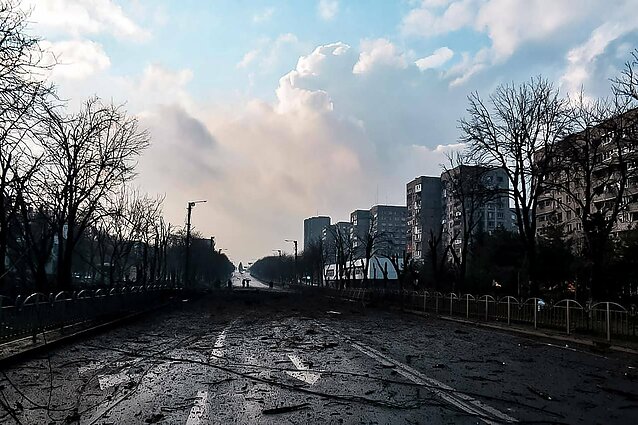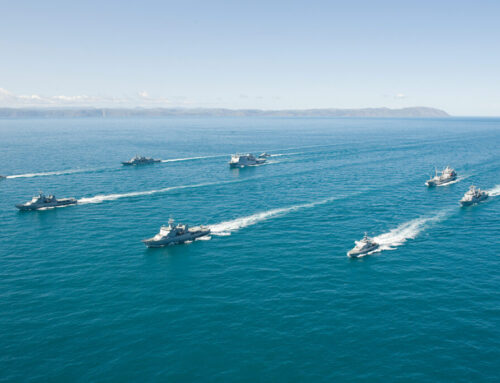PULASKI POLICY PAPER Russian Approach to Siege Warfare in practice Kyiv vs Mariupol (Sebastian Czub)
Autor foto: Domena publiczna



PULASKI POLICY PAPER Russian Approach to Siege Warfare in practice Kyiv vs Mariupol (Sebastian Czub)
Autor foto: Domena publiczna
Russian Approach to Siege Warfare in practice. Kyiv vs Mariupol
Autor: Sebastian Czub
Opublikowano: 6 grudnia, 2022
Pulaski Policy Paper no 28, December 6 2022
Lesson from Ukraine: Russian Approach to Siege Warfare
It has been nine months since the start of the Russian invasion of Ukraine. During this time an unprecedented number of battles and engagements could have been observed. There is however a certain type of warfare that attracts much more attention than others – both from the parties engaged in the conflict as well as the general public. Siege warfare. The news reports and footage from besieged Ukrainian cities of Kyiv, Kharkiv, Kherson and most prominently Mariupol, have deeply embedded themselves into the collective psyche of not only Ukrainians but Europeans as well. With scenes of devastation bringing out the memories and horrors of the darkest days of World War II. This paper serves as an overview of Russian approach to siege scenarios examining Russian military doctrine, its implications for siege warfare and case studies on how sieges are executed by Russian forces.
Strategic importance of cities
Cities are extremely important to the war effort for two important reasons. Firstly, they accommodate the majority of a country’s critical infrastructure – seats of government, administration centres, transport hubs, industrial infrastructure, and energy infrastructure. These targets maintain and organise the livelihood of the country’s entire population, providing them with necessary goods and services. The second reason is the very question itself. Cities house the majority of any country’s population and thus controlling it allows it to control the population. This can be seen in the example of the first days of the Russian invasion of Ukraine, with the cities of Kyiv, Kharkiv, Mariupol and Melitopol being the primary targets. Kyiv is home to 2.8 million people as well as the seat of the Ukrainian government. Kharkiv is another major population centre with critical industrial infrastructure. Mariupol is also a major industrial centre, with the mighty Azovstal Metalworks, and a large trade port. Whie Melitopol is a critical inland transport hub, now used by Russian forces to fuel the front around Kherson.
Russian Military Doctrine
The Russian Armed Forces have changed greatly in comparison to their soviet predecessors. Over the past ten years the Russian Armed Forces transitioned from reliance on mobilised men to professional soldiers. While mobilised troops are still very much present, and key in Russian military doctrine, it is the professional core that conducts the majority of operations. The operations themselves are aimed to be swift and decisive using specialised forces to deal crippling blows to the enemy – a coup de main. These forces primarily consist of Spetsnaz (special forces), Vozdushno-desantnye voyska (Airborne forces) further referred to as VDV, and Naval Infantry – each highly mobile and able to put light mechanised forces on the field – perfect for conducting lighting operations and swift engagements, within combined arms operations. After securing initial objectives Russian forces would assume a defensive stance in order to consolidate the gains and reinforce. This could be observed recently during Russian operations in Crimea in 2014.
However, if a protracted combat operation is required their military doctrine dictates to prioritise swift elimination of command and control systems, forcing their opponents into disarray. This is further complemented by the use of maskirovka – the practice of disinformation, use of decoys and deceptions while concealing true intentions and disposition of forces in order to confuse and misdirect enemy forces. In addition Russian forces would maintain a high rate of advance in order to limit the ability of opposing forces to prepare and react. In the event of encountering peer or near-peer level enemy forces the Russian doctrine dictates to avoid a direct engagement, rather the Russian forces are encouraged to conduct blokirovanie – blocking tactics. Russian troops will block, and/or hem in order to limit enemy mobility, the then immobilised enemy forces will be targeted and destroyed by fires – artillery barrages, precision missile strikes etc.. This approach is reflected in the structure of the Russian Armed Forces, which have smaller manoeuvre elements and more extensive fire support elements. For example a Russian motor rifle brigade will consist of three motor battalions, one tank battalion and between three and four fire support battalions, whereas a US detachment of the same size will field only a single fire support battalion. The reliance on artillery pays very well into siege scenarios, during which bombardments can take an enormous toll on fixed defences and surrounded defending forces.
Thus while still heavily influenced by their Soviet past, modern armed forces of Russia no longer rely on numerical superiority and direct confrontation. The current doctrine drives Russian forces to perform decisive lighting strikes, focusing on mobility and disinformation to disrupt opposing forces. Head-on engagements against peer enemies are discouraged in favour of fires using ground based artillery as well as missile and drone strikes, aimed to shatter enemy forces before engaging with mobile troops.
Russian Approach to Siege Warfare in practice Kyiv vs Mariupol
Kyiv
The Russian attack on Kyiv at the beginning of the war is a great example of a failed Russian siege scenario. It shows what Russian forces do when the initial coup de main fails to accomplish their set objectives.
The Russian attack on Kyiv was a combined arms operation, aimed to execute a coup de main on the Ukrainian capital. If successful it would have allowed the Russian forces to cripple the Ukrainian government and command structure. In order to achieve this objective the Russian amassed a vast array of forces, which by working in concert would allow for the seizure of strategic targets in and around Kyiv. First and vitally important for this entire endeavour were the VDVs most likely of the elite 31st Guards Air Assault Brigade who were tasked with securing the Gostomel airport – an important military installation to the west of Kyiv. Further airborne units were tasked with landing and taking control of Kyiv’s southeastern Boryspil airport. The airborne units were to swiftly overwhelm the airports’ defenders and hold them until reinforced by Russian forces arriving from Belarus. These forces would push southwards onto Kyiv on both sides of the Dnieper river. The western force would link up with the 31st Guards in Hostomel, securing the airport, thus allowing for air resupply and reinforcement directly from Russia, while at the same time denying it to Ukrainian air forces. The eastern force would follow a similar approach, pushing all the way to Boryspil airport and securing a base there. Together the two forces would encircle Kiev and cut off the civilian and military leadership from the rest of the country. This approach directly follows Russian doctrine, using elite forces to deal a swift and decisive blow to the enemy while using speed and lack of information to not engage enemy peer-level forces head on.
Why did Russian forces fail to capture Kyiv?
However this operation failed due to several reasons. The VDV units landing in Gostomel and Boryspil encountered heavier resistance than expected – this resulted in Boryspil not being captured. While the airborne units succeeded in capturing Gostomel airport, the reinforcements from Belarus were delayed by Ukrainian defenders in Chernobyl, which was used by Ukrainian troops in Kyiv who retook Gostomel. Although the Russian ground forces managed to push through Chernobyl and enter northwestern Kyiv, they lost the advantage of air resupply and the ability to swiftly encircle Kyiv – now being forced to engage head on with the Ukrainian counter attack. Something similar happened in the east where Russian reinforcement columns, aiming to quickly encircle Kyiv from the east and capture Boryspil airport, were engaged by Ukrainian troops in Chernihiv, around one hundred kilometres away from their original targets. Thus, the Russians failed to capture Kyiv in a swift and decisive manner, being forced into an unfavourable prolonged battle in northwestern Kyiv and in the northeast around Chernihiv.
Though the initial planned assault on Kyiv failed the Russian forces still possessed enough assets to overcome Ukrainian defences. Relying on their military doctrine Russian troops in northwestern Kyiv and Gostomel conducted blokirovanie – units engaged with the enemy were tasked with blocking or limiting their ability to manoeuvre, either by exerting pressure on the frontline or threatening strategic targets. The then pinned Ukrainian forces were targeted by Russian artillery fire. At the same time fresh troops arriving from Belarus utilised their mobility to push towards Zhytomyr Oblast – hoping to outflank Ukrainian defenders west of Kyiv already engaged with Russian troops conducting blokirovanie. This manoeuvre could successfully encircle Kyiv from the west, while a new attack launched from Sumy in the east would complete it. However Ukrainian reinforcements manage to halt both attacks, inflicting heavy casualties on Russian forces in the east. Coupled with supply issues due to long supply lines from either Belarus or Sumy, vulnerable to attacks from Ukrainian artillery and air assets lead to gradual attrition among Russian forces, unsuited for prolonged combat which in turn resulted in the pullback from Kyiv.
The assault on Kyiv, while unsuccessful, is still a very good example of Russian ability to conduct sieges. The lightning strikes onto Kyiv’s two major airports, coupled with simultaneous assaults from the Belarusian border, clearly show Russian ability to organise and execute combined arms operations at terrifying speeds. Furthermore this operation also showcases Russian ability to swiftly transition from highly mobile assaults to a more static approach using blocking tactics and artillery fires to neutralise peer-level opponents. On the other hand however the assault on Kyiv also clearly shows Russian weaknesses – the inability for long term sustained combat operations, due to overstretched supply lines and reliance on a small core of elite units, as well as failure to properly judge available enemy forces.
Mariupol
The siege of Mariupol is a very important example of a successful Russian siege. It shows in great, albeit gruesome, detail how siege scenarios executed by Russians develop after the success of the initial swift strike stage.
The assault on Mariupol was key in the Russian invasion of Ukraine as the port city and its sizable garrison stood directly between the pro-Russian republics of Donetsk and Luhansk, and the Russian breakout from Crimea. The city had to be taken to secure the Russian push into Southwestern Ukraine and stabilise the frontlines in the Donbass region. Furthermore the city housed major industrial installations which could be used by Ukraine in the conflict.
In order to complete the set out objectives the Russian forces devised a plan relying heavily on their established doctrine that mitigated their weaknesses in peer to peer combat. Firstly Russian forces conducted a swift and decisive push from northeast and east which tied up Mariupol’s garrison. At the same time artillery was used to target Ukrainian soldiers and eastern parts of Mariupol. This frontal approach from the northeast also served as a maskirovka, a key aspect of the entire operation, and one that was not utilised in the assault on Kyiv, as it drew attention away from the more serious western push. From Crimea a large number of Russian forces, spearheaded by the elite 7th VDV Division, struck towards Kherson, Zaporizhia, and Melitopol, thus beginning to cut off Mariupol from other Ukrainian forces. On 27th February, three days after the start of eastern assault on Mariupol Russian forces conducted an amphibious landing operation west of Mariupol – around 2000 soldiers of the elite marine infantry. On the same day the marines along with more Russian forces from the Crimean breakout complete the encircling of Mariupol – unopposed as Ukrainians were focused on the eastern assault and continuous artillery fire on the city. The initial swift strike part of the assault is crucial as it allows the Russians to set up a comprehensive siege. In Mariupol Russian forces utilised all of their available assets – blocking tactics and maskirovka, drawing attention away from the elite Marine Infantry and VDVs executing the encircling manoeuvre – cutting off the city from reinforcement. In Kyiv on the other hand, elite VDVs, after their initial insertion and lighting strikes, were forced to engage in direct combat with peer level forces – for which they were not suitable. The Kyiv assault also lacked convincing deceptions or blocking tactics that could allow the elite troopers to successfully achieve the encircling manoeuvre.
The siege of the city itself was also done in accordance with Russian doctrine. The besieging forces exerted pressure on the Ukrainian defenders, forcing them to respond in targeted areas, which in turn created perfect opportunities for the overwhelming Russian artillery. After the devastating barrage, Russian troops would move in, thus step by step reducing the pocket. This also couldn’t have been achieved in Kyiv due to the flexibility of Ukrainian lines, ability to conduct counterfires, as well as limited Russian ability to resupply their artillery. Another key aspect of the Russian artillery supremacy, which has to be discussed in greater detail, was that it allowed for the widespread bombardment of the city – destroying critical infrastructure and civilian casualties. For example the destruction or at the very least disruption of the road and transport network within Mariupol itself hampered the ability of the defenders to move around the city and respond to Russian assaults. The destruction of energy and water infrastructure also served to weaken Ukrainian forces, disrupting their communication networks, command structure, and their ability to sustain their troops and civilian population. Which brings about the last issue – the defenders responsibility and duty to the civilian population. The extensive bombardment of the city led to great harm among its civilian population, which in turn led to more strain on the military personnel. The defenders not only had to contest Russian forces but also use its forces to help the civilians – rescuing them from ruined buildings, providing food, shelter, and medical attention. This additional responsibility weakened the already hard pressed Ukrainian defences. On the other hand in Kyiv this presure could not be exerted to such an extent, as the failed encircling manoeuvre allowed many civilians to evacuate, while the ones who chose to remain were well protected by the extensive network of public bomb shelters, including the Kyiv Metro System. After several weeks of bombardment and gradual reduction of the pocket the Russians mounted a major assault on the centre of the city, using elite troops of Marine Infantry to destroy and/or disrupt Ukrainian leadership and command. Ukrainian forces are forced into isolated pockets of resistance, the most notable one at the Azovstal Metalworks – where the Azov Battalion mounted a valiant and coordinated defence. The Russians troops again fell on their doctrine and used artillery fires to eliminate the blockaded defenders.
The assault and siege of Mariupol clearly shows how Russian doctrine and military structure play very well into siege scenarios. The elite and highly mobile units like VDVs, Spetsnaz or Marines Infantry are used to encircle the cities and strike critical targets such as road junctions, airports etc. – preferably avoiding any engagements with peer-level forces. Once the encirclement is complete the besieging forces switch stances, going from mobile and swift assault to blocking tactics, locking in targets for the artillery to fire upon. Once the defending forces have been weakened enough the attackers again switch using elite forces to strike critical targets. This doctrine allows Russia to quickly isolate large amounts of soldiers and take strategic targets. Furthermore the quick and organised transitions from swiftness and mobility of elite formations into more static approach of blocking line troops and artillery fires mitigates Russian casualties while causing catastrophic damage to the enemy.
Conclusions
- Despite evident Russian failure during the war in Ukraine, it is vital to remember the capability of Russian forces. Russians are able to execute combined arms operations, to a devastating effect. Mobile strike groups, airborne units, armoured vehicles, and artillery, operate in concert.
- Russian forces will in most cases have the artillery advantage, which will be often utilised to great effect. They are however dependent on a stable supply of ammunition. Drawn out engagements away from supply depots will put pressure on Russian ability to sustain long lasting barrages. Any threats to supply lines will put an enormous strain on the Russians ability to conduct fires.
- Russian use of highly mobile elite formations and their tendency to avoid peer to peer engagements should be taken into account. These semi-independent formations can strike critical targets, secure important transport hubs, or conduct devastating encircling manoeuvres.
- The extensive practice of maskirovka by Russian forces grant them an edge over opposing forces. Intel gathering and reconnaissance should be extensive, furthermore it should be subject to exhausting examination.
- As a lesson from Ukraine, Poland should understand the capability of Russian artillery. Poland should explore ideas on how to protect not only its military but also citizens from the large-scale destruction and loss of life that can be caused by Russian bombardment. Modernisation of public bomb shelters, as well as defensive weapons capable of shooting down incoming projectiles should be explored. One might look to Israeli Iron Dome for inspiration.
- Russian failures, especially in Kyiv, will, in most probability, result in adaptation of the Russian war machine. Mariupol will, most probably, be used as a guiding example for further Russian sieges.
- Lastly, the mobilisation of 300,000 soldiers will influence the behaviour and ability of Russian forces. The weakness of peer-to-peer engagements may be somewhat mitigated by the introduction of more numerous frontline troops, thus giving elite formations more space to conduct their operations.
Author: Sebastian Czub, external contributor






